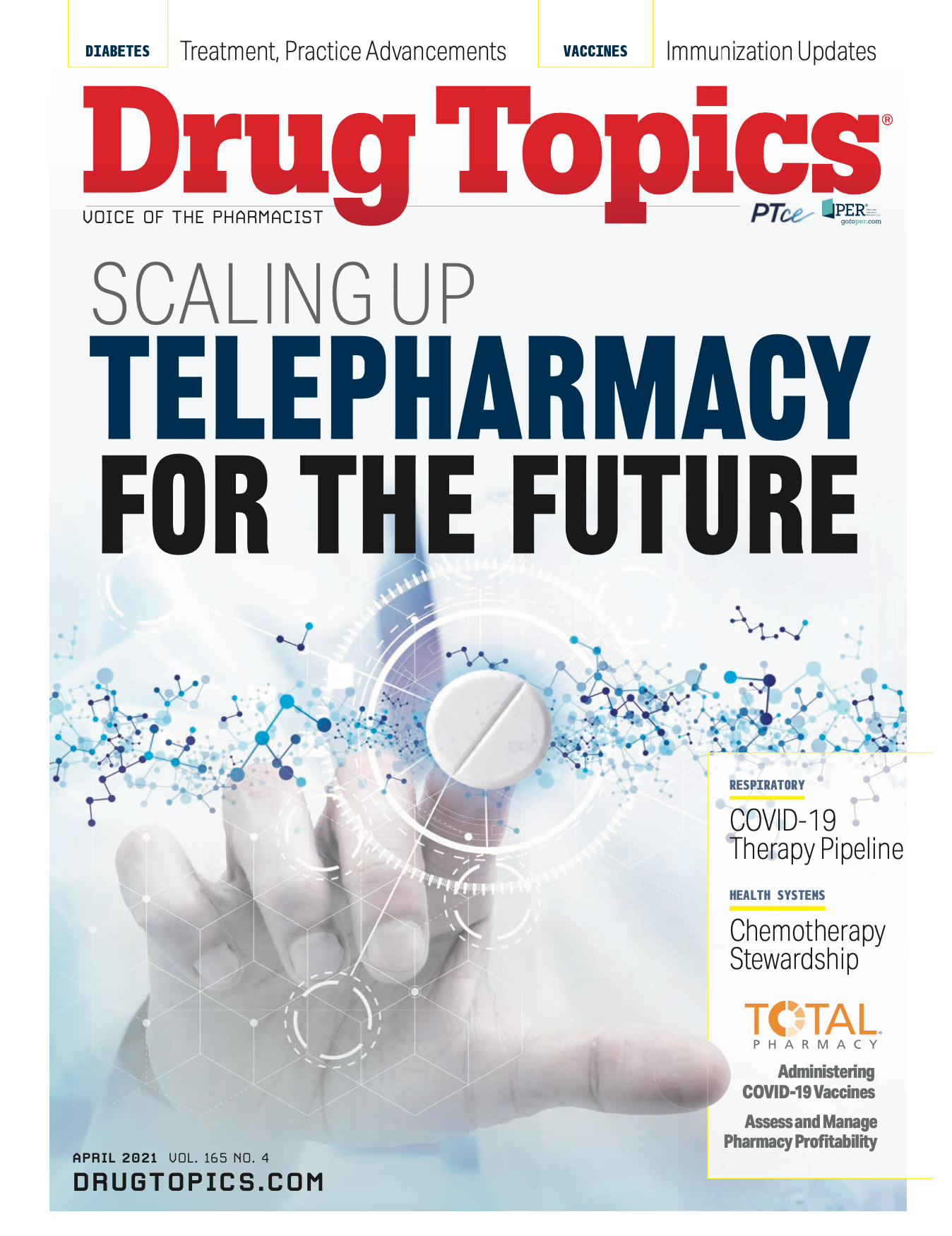Warfarin, a lifesaving medication, is commonly used to treat blood clots and reduce their occurrence, thus preventing heart attack, stroke, or other serious conditions such as deep vein thrombosis in the legs or a pulmonary embolism in the arteries of the lungs.
Warfarin is a derivative of a naturally occurring substance originally discovered in 1940 as a compound in moldy hay.1 In 1948, the substance was marketed as rat poison. Because of its high degree of acute oral toxicity, warfarin is in the FDA’s Toxicity Category I, the most serious such designation.
Elizabeth Isaac, PharmD, a medication safety pharmacist at UMass Memorial Medical Center in Worcester, Massachusetts, said safe disposal of warfarin requires pharmacists to contract with a biomedical waste vendor. Patients taking warfarin are advised to go on birth control as warfarin can interfere with fetal development.2 It is also important for women who are pregnant or breastfeeding and men who want to become fathers to take precautions when handling this substance, Isaac added.
Prioritize Pharmacy Waste Management
Pharmacists are busy but focusing on pharmacy waste must be a priority, said Isaac. “[For one thing] we know that pharmaceutical waste, if not disposed of correctly, can end up in our drinking water….The [Environmental Protection Agency (EPA)] has come out with guidance about not allowing pharmaceutical waste into our water supply,” she said.
4 Medications You Might Not Know Are Hazardous
Chemotherapy drugs. They’re classified as an antineoplastic drug, along with cytotoxic and oncology drugs. Working with these substances during pregnancy could impact a woman’s chance of miscarriage or having a child with a birth defect.
Lindane. This substance is formulated in low concentrations in shampoo to treat head lice and is only applied for brief periods of time. It’s highly toxic to humans, which means it has to be kept out of drinking water.
Inhalers. Although the drugs inside inhalers aren’t considered hazardous, they are stored in compressed gas; this means they could be combustible.
Nicotine, depending on the state where you practice. This substance was reevaluated by the Environmental Protection Agency in January 2020 for removal as hazardous, but not all states have adopted this change.
In addition, results of a 2015 study3 showed that pharmaceuticals in treated wastewater released into streams and other bodies may affect fish. The pharmaceuticals included in the study were hydrocodone, methadone, oxycodone, tramadol, methocarbamol, fluoxetine, paroxetine, venlafaxine, and temazepam.
Isaac said pharmacists should work with waste management vendors and their colleagues in hospital-based environmental health and safety departments for guidance on appropriate disposal of drugs.
She also has some practical advice: Creating open and clearly labeled containers to capture pharmaceutical waste is a must. “You need to make it as easy as possible [for employees] to do the right thing.”
Understand the Relevant Federal and State Agencies
Chris Smith, RPh, director of product strategy for provider solutions at Inmar Intelligence, a Winston-Salem, North Carolina-based technology and data analytics services provider, observes that there are numerous federal and state agencies engaged in regulating pharmaceutical drugs.
Specifically, he recommends that pharmacists learn how the various drug lists published by the Resource Conservation and Recovery Act, the United States Pharmacopeial Convention (USP) USP 800, and the National Institute for Occupational Safety and Health (NIOSH) may affect their pharmacies.
“It’s super-important to understand the various lists of drugs because the EPA list is different from the USP 800 list. Additionally, NIOSH, [a] subsidiary of the CDC, has undergone extensive changes to their list and [has] published a new draft list in 2020 that is up for approval now.”
The implications of these changes are numerous, including additions and removals of various active product ingredients and their classifications, said Smith. NIOSH recently communicated that modifications to its list should be approved in 2021, he added.
Keep Track of Medication Expiration Dates
Results of a 1963 study5 showed that a form of tetracycline, an antibiotic that can be used to treat acne and skin infections, caused renal tubular acidosis when outdated. However, some researchers disputed4 this finding. Other medications lose their potency over time. Examples include oral nitroglycerin, insulin, anticonvulsant, warfarin, digoxin, thyroid preparations, and oral contraceptives.6
According to the FDA,7 certain expired medications can succumb to bacterial growth, whereas antibiotics that have lost their potency may be unsuccessful in treating infections, which can result in more serious illness and antibiotic resistance.
Most medications expire when they get to approximately 90% effectiveness, said Timothy Burkart, PharmD, an assistant professor of clinical practice in pharmacy at the University of Findlay in Findlay, Ohio. After that, the chemicals start to break down and the medications become less stable.
Managing medication expiration dates is often done manually, explained Burkart. That means an intern pharmacist or a pharmacy technician will each be responsible for their own section of the pharmacy where they are tracking expiration dates. Once a month, they’ll look at the medications’ expiration dates and pull to the front medications that will expire after a year. An easy way to manage expiring medications is to flag them by marking the label with a bright dot, he said. Medications that are due to expire within a year should be pulled off the shelves and disposed of appropriately, advised Burkart.
Stephen Eckel, PharmD, MHA, associate dean for global engagement and associate professor at UNC Eshelman School of Pharmacy in Chapel Hill, North Carolina, said that although pharmacy interns and technicians can do this work, it is ultimately the pharmacist’s responsibility.
There are costs associated with having these medications incinerated, which is something pharmacy leaders should know, added Eckel. Expired medications are less likely to be an issue at retail pharmacies, where less inventory is kept on hand. By contrast, it is much more time-consuming and an ongoing process at hospital pharmacies where inventory is higher, he explained.
Isaac said hospital pharmacists should sustain relationships with team members in the environmental health and safety department who work closely with waste management vendors. It is just as important to work collaboratively with nurse managers throughout the hospital about proper medication disposal, she added.
Participate in Drug Take Back Days
Expired or unused medications can have a negative impact on the environment and their communities. For example, unused opioid medications that are not disposed of appropriately can be diverted and exacerbate the nation’s opioid crisis, said Burkart. Burkart has helped organize Drug Take Back Days, where members of the public can safely and easily turn in prescription drugs.
Overdose death accounts reached more than 86,000 people for the 12-month period that ended in July 2020, STAT reported in March.8 Nora Voklow, MD, director of the National Institute on Drug Abuse, told STAT, “2020 has by far the highest number of [overdose] deaths.”
Pharmacists can participate in National Prescription Drug Take Back Day, which occurs on April 24 this year. They can also plan events with local law enforcement, said Burkart.
Partnering with local law enforcement is a must because opioids are regulated by the United States Drug Enforcement Administration, among other federal and local agencies, he explained. “There are special rules about how you get rid of these drugs. They have to be taken out of circulation from the general population.”
Typically, opioid medications are destroyed through incineration at locations—sometimes old steel mills—at high temperatures. Filters are used to manage the release of smoke, which prevents the smoke from leaking into the environment, Burkart explained.
Engage in Ongoing Planning and Education
Smith advises pharmacists to conduct a thorough assessment of the pharmacy through the lens of regulatory compliance, employee and patient safety, and public safety. Also helpful is building a plan for handling exposures, spills, or other potentially harmful incidents; the plan should inform policies that deter abuse and diversion, he added.
Pharmacists must provide training for staff and patients, said Smith. Staff members need to know what to do if an incident occurs. Equally important, patients need to know about safe medication disposal techniques; advertising Drug Take Back Days helps, as does providing a drug take-back kiosk at the pharmacy, he said.
References
1. Lim GB. Warfarin: from rat poison to clinical use. Nat Rev Cardiol. Published online December 14, 2017. doi:10.1038/nrcardio.2017.172
2. Mayo Clinic. Warfarin (Oral Route). IBM Micromedex. Updated February 1, 2021. Accessed March 4, 2021.https://www.mayoclinic.org/drugs-supplements/warfarin-oral-route/precautions/drg-20070945.
3. Understanding how pharmaceuticals in the environment affect fish. News release. U.S. Geological Survey. November 13, 2015. Accessed March 4, 2021. https://www.usgs.gov/news/understanding-how-pharmaceuticals-environment-affect-fish
4. Gross JM. Fanconi syndrome (adult type) developing secondary to the ingestion of outdated tetracycline. Ann Internal Med. 1963;58:523-528.
doi:10.7326/0003-4819-58-3-523
5. Drug expiration dates — do they mean anything? Harvard Health Publishing. Updated August 9, 2020. Accessed March 4, 2021. https://www.health.harvard.edu/staying-healthy/drug-expiration-dates-do-they-mean-anything
6. Shapiro M. The truth about expired meds. AARP. December 15, 2015. Accessed March 4, 2021. https://www.aarp.org/health/drugs-supplements/info-2015/expired-medication.html
7. Don’t be tempted to use expired medicines. FDA. Updated February 8, 2021. Accessed March 4, 2021. https://www.fda.gov/drugs/special-features/dont-be-tempted-use-expired-medicines
8. Facher L. The ‘other’ epidemic: amid Covid-19, addiction experts fear Biden could back-burner the overdose crisis. STAT. March 2, 2021. Accessed March 4, 2021. https://www.statnews.com/2021/03/02/addiction-overdose-crisis-covid-biden-backburner/
9. Environmental Protection Agency. § 261.33. 40 CFR Ch. I (7–1–19 Edition). 2019. Accessed March 8, 2021. https://www.govinfo.gov/content/pkg/CFR-2019-title40-vol28/pdf/CFR-2019-title40-vol28-sec261-33.pdf

